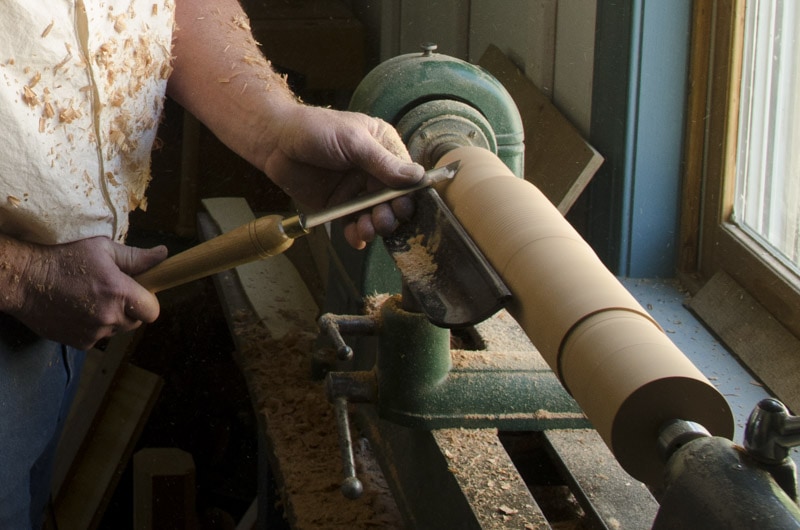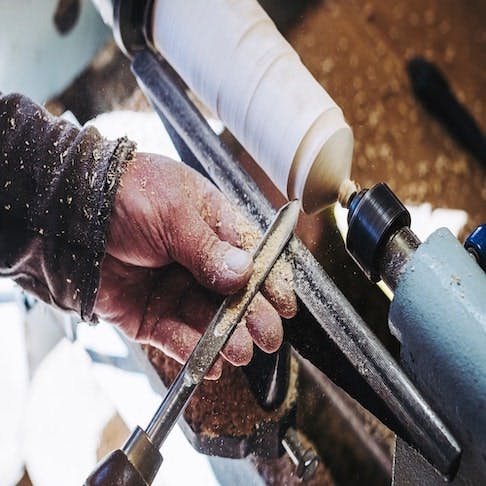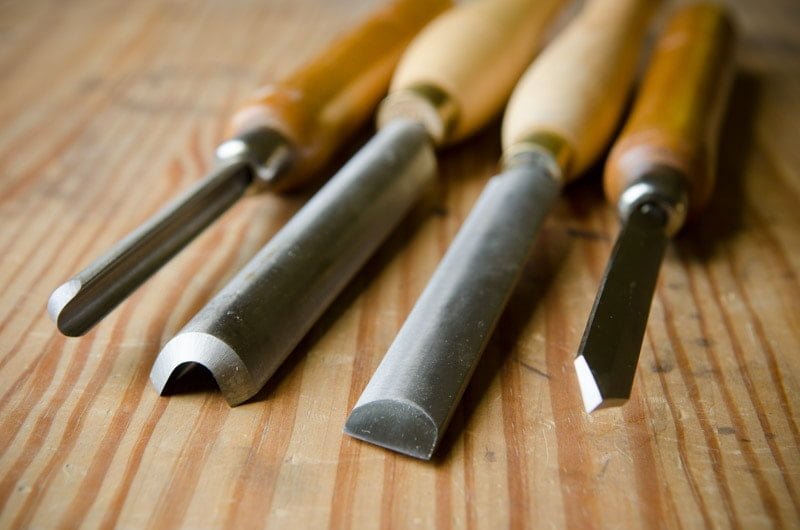Table of Contents
Wood lathe turning chisels are essential tools for shaping and detailing wood on a lathe. They come in various types, each designed for specific tasks.
Wood lathe turning chisels are vital for any woodturning project. These tools allow for precise cutting, shaping, and detailing of wood pieces on a lathe. Different chisels serve unique purposes, such as roughing out, detailing, and finishing. Common types include spindle gouges, bowl gouges, skew chisels, and parting tools.
Choosing the right chisel depends on the specific task and the wood being used. Proper use and maintenance of these chisels ensure smooth and clean cuts, enhancing the quality of the finished product. Investing in high-quality chisels can significantly improve your woodturning experience and results.

Credit: www.amazon.com
Introduction To Wood Lathe Turning Chisels
Wood lathe turning chisels are essential for shaping wood. They help you create intricate designs. Knowing the types of chisels can improve your woodworking skills.
The Role Of Chisels In Woodturning
Chisels are the main tools used in woodturning. They cut and shape the wood on a lathe. The lathe spins the wood while you control the chisel.
Different chisels offer different cuts. Some are good for roughing out shapes. Others are perfect for fine details. Each type has a unique function.
Varieties Of Turning Chisels
There are many types of wood lathe turning chisels. Here are a few common ones:
- Roughing Gouge: Used for removing large amounts of wood.
- Spindle Gouge: Ideal for detailed work on spindles.
- Parting Tool: Helps in making precise cuts and separating pieces.
- Bowl Gouge: Best for shaping and hollowing bowls.
- Scraper: Smooths out surfaces and removes fine shavings.
Each chisel has a specific use. Choosing the right chisel can make your job easier. Let’s look at a table summarizing their uses:
| Chisel Type | Primary Use |
|---|---|
| Roughing Gouge | Removing large amounts of wood |
| Spindle Gouge | Detailed work on spindles |
| Parting Tool | Making precise cuts |
| Bowl Gouge | Shaping and hollowing bowls |
| Scraper | Smoothing surfaces |
Knowing the right chisel helps you achieve better results. Practice and experience also play a big role.
Essential Chisel Types
Wood lathe turning chisels are essential tools for woodworkers. Each chisel type has a unique role in shaping and finishing wood. Understanding these essential chisel types can improve your woodworking skills.
Gouges: The Shaping Masters
Gouges are the primary tools for shaping wood on a lathe. They come in various shapes and sizes, each designed for specific tasks. The most common types of gouges are:
- Roughing Gouge: Used for removing large amounts of wood quickly.
- Spindle Gouge: Ideal for detailed work on spindle projects.
- Bowl Gouge: Perfect for hollowing out bowls and other curved shapes.
A table summarizing the gouges:
| Gouge Type | Primary Use |
|---|---|
| Roughing Gouge | Removing large amounts of wood |
| Spindle Gouge | Detailed spindle work |
| Bowl Gouge | Hollowing out bowls |
Skews: For Smooth Finishing
Skew chisels are used for achieving a smooth finish on wood. They are tricky to master but offer excellent results when used correctly. Skews can perform various tasks, such as:
- Smoothing: Creating a smooth surface on the wood.
- Detailing: Adding fine details to your project.
- Planing: Making precise, flat cuts.
Using skews correctly can significantly enhance the quality of your work.
Parting Tools: Defining Boundaries
Parting tools are essential for defining boundaries and cutting wood to size. They are also known as cut-off tools. Their primary functions include:
- Cutting: Separating a finished piece from the rest of the wood.
- Grooving: Creating grooves and recesses in your project.
- Measuring: Ensuring precise dimensions and cuts.
Parting tools help achieve accuracy and precision in your woodworking projects.
Material Choices For Chisels
Choosing the right material for wood lathe turning chisels is crucial. The material impacts the chisel’s performance and durability. Let’s explore the main options available.
High-speed Steel Versus Carbon Steel
High-Speed Steel (HSS) and Carbon Steel are common chisel materials. Each has unique advantages.
| Feature | High-Speed Steel (HSS) | Carbon Steel |
|---|---|---|
| Hardness | Very hard, stays sharp longer | Less hard, dulls quicker |
| Heat Resistance | Excellent, withstands high temperatures | Lower, can overheat easily |
| Maintenance | Low, needs less frequent sharpening | High, requires regular sharpening |
| Cost | More expensive | Less expensive |
Benefits Of Carbide-tipped Chisels
Carbide-tipped chisels offer several benefits over traditional steel chisels. They combine the toughness of steel with the hardness of carbide.
- Long-lasting sharpness: Carbide tips stay sharp much longer.
- Less sharpening: Spend more time turning, less time sharpening.
- Durability: Carbide is extremely hard, making it very durable.
Carbide-tipped chisels are ideal for heavy-duty woodturning. They are preferred by both hobbyists and professionals.
Handle Design And Ergonomics
The handle design and ergonomics of wood lathe turning chisels are crucial. A well-designed handle offers better control and reduces fatigue. The comfort of the handle affects the quality of your work. Let’s explore different handle designs.
Traditional Wooden Handles
Traditional wooden handles are popular among woodturners. They are made from hardwoods like maple, ash, or beech. Wooden handles are durable and offer a natural feel. They are often shaped to fit comfortably in the hand.
- Material: Maple, Ash, Beech
- Comfort: Natural feel, comfortable grip
- Durability: Long-lasting with proper care
Modern Alternatives: Composite And Metal
Modern handles are made from composite materials and metal. These materials provide enhanced durability and precision. Composite handles are lightweight and resistant to moisture. Metal handles offer a sleek design and excellent balance.
| Material | Advantages | Disadvantages |
|---|---|---|
| Composite | Lightweight, moisture-resistant | Less natural feel |
| Metal | Durable, balanced | Heavier |
Choosing the right handle is important. It impacts your control and comfort. Consider your preferences and the type of woodturning projects you undertake. Both traditional and modern handles have their unique benefits.
Sharpening Techniques
Keeping your wood lathe turning chisels sharp is crucial. Sharp tools make cleaner cuts and are safer. Learn these sharpening techniques to master your craft.
The Art Of Sharpening
Sharpening is an art and a skill. It’s about precision and patience. Here are the steps to follow:
- Start with a coarse stone to shape the edge.
- Move to a medium stone to refine the edge.
- Finish with a fine stone for a razor-sharp edge.
Always maintain a consistent angle. Use a honing guide if needed. This ensures a uniform edge.
Maintaining The Edge: Tips And Tricks
Regular maintenance keeps your chisels sharp longer. Here are some tips:
- Hone your chisels after each use. This keeps the edge sharp.
- Store your chisels properly. Use a tool roll or a magnetic strip.
- Avoid hitting the chisels on hard surfaces. This can dull the edge.
Here’s a table with the types of stones and their uses:
| Stone Type | Use |
|---|---|
| Coarse | Shaping the edge |
| Medium | Refining the edge |
| Fine | Polishing the edge |
Advanced Chisel Techniques
Wood lathe turning chisels can create amazing shapes. Advanced chisel techniques allow for intricate designs. Master these techniques to enhance your woodturning skills.
Beads And Coves: Detailed Work
Beads and coves are fundamental shapes in woodturning. Beads are small, rounded shapes. Coves are concave curves. These shapes add detail and beauty to your projects.
| Shape | Description |
|---|---|
| Bead | A small, rounded protrusion. |
| Cove | A small, concave curve. |
To create beads and coves, use a spindle gouge. Follow these steps:
- Hold the gouge at a 45-degree angle.
- Use short, controlled cuts.
- Rotate the tool to follow the desired curve.
Hollowing: Mastering Depth And Curvature
Hollowing creates depth in woodturning projects. Mastering this technique can make bowls and vases.
Use a bowl gouge or a hollowing tool. Follow these steps for effective hollowing:
- Start at the center and work outward.
- Keep the tool rest close to the work.
- Make smooth, even cuts.
- Check the depth frequently.
Advanced chisel techniques require patience and practice. Keep your tools sharp. Use proper safety gear. Happy turning!
Safety Considerations
Using wood lathe turning chisels can be both rewarding and dangerous. Ensuring proper safety measures can prevent accidents and injuries. Below are essential safety considerations for woodturning enthusiasts.
Proper Handling
Proper handling of wood lathe turning chisels is crucial. Always use both hands to maintain control. One hand should hold the handle, and the other should guide the tool. Keep your workspace clean to avoid tripping over debris.
When not in use, store chisels safely. Use a chisel rack or magnetic strip to keep them organized. Sharp tools should be kept away from children and pets. Regularly inspect your chisels for damage. Damaged tools can lead to accidents.
Protective Gear For Woodturning
Wearing protective gear is essential for safety. Always wear safety glasses to protect your eyes from flying wood chips. A face shield provides extra protection. Wear a dust mask to avoid inhaling wood dust.
Use hearing protection if your lathe is noisy. Gloves can protect your hands, but ensure they fit snugly. Loose gloves can get caught in the lathe. Wear a long-sleeve shirt and long pants to protect your skin.
Here is a checklist for protective gear:
- Safety Glasses
- Face Shield
- Dust Mask
- Hearing Protection
- Snug-fitting Gloves
- Long-sleeve Shirt
- Long Pants
Chisel Care And Maintenance
Proper care and maintenance of your wood lathe turning chisels ensure their longevity and performance. Taking a few minutes to clean and store your chisels correctly can make a big difference. Follow these simple steps to keep your chisels in top shape.
Cleaning Best Practices
Cleaning your chisels after each use is essential. This prevents build-up and rust. Use a soft cloth to wipe off any wood shavings and dust. For stubborn dirt, a damp cloth can help.
- Wipe off any wood shavings and dust.
- Use a damp cloth for stubborn dirt.
- Dry the chisel thoroughly to prevent rust.
If your chisel has rust, use fine-grit sandpaper. Gently rub the rusted area until it is clean. Apply a light coat of oil to protect the metal. This keeps your chisel sharp and ready for use.
Storage Solutions For Longevity
Storing your chisels properly can extend their lifespan. Keep them in a dry and cool place. Avoid humid areas which can cause rust.
| Storage Solution | Benefits |
|---|---|
| Tool Rack | Keeps chisels organized and easy to access. |
| Tool Roll | Portable and protects chisels from damage. |
| Magnetic Strip | Holds chisels securely and prevents dulling. |
Always store chisels with the sharp edge covered. This prevents accidents and keeps the blade sharp. You can use blade guards or sheaths for added protection.
Following these cleaning and storage tips will help keep your chisels in great condition. Well-maintained chisels perform better and last longer, making your woodworking projects more enjoyable.
Projects And Applications
Wood lathe turning chisels open up a world of creativity. These tools help in crafting various items from wood. Projects range from simple to complex. Understanding the right projects for your skill level is key.
Beginner-friendly Projects
Starting with easy projects helps build confidence. Here are some ideas for beginners:
- Wooden Pens: Start with basic shapes. Wooden pens are small and easy.
- Candle Holders: Simple and functional. Practice basic cuts and shapes.
- Bowls: Small bowls teach basic hollowing techniques.
- Spindle Work: Create simple spindles. Perfect for learning different cuts.
These projects help you master basic skills. Each project enhances your control and precision.
Complex Designs For Experienced Craftsmen
Experienced craftsmen can take on more intricate tasks. Here are some advanced projects:
- Intricate Vases: Combine shapes and patterns. Experiment with different wood types.
- Detailed Bowls: Add complex designs and fine details.
- Furniture Legs: Create detailed and sturdy furniture parts.
- Decorative Boxes: Incorporate lids and compartments. Add fine details.
Advanced projects push your skills further. Each complex design requires patience and precision.

Credit: woodandshop.com

Credit: www.xometry.com
Frequently Asked Questions
What Chisel To Use For Wood Turning?
For wood turning, use gouges, skews, parting tools, and scrapers. Each chisel type serves specific purposes. Ensure they are sharp for best results.
What Chisels Do I Need For A Lathe?
You need several chisels for a lathe: roughing gouge, spindle gouge, skew chisel, parting tool, and bowl gouge.
How Sharp Should A Wood Turning Chisel Be?
A wood turning chisel should be razor-sharp. A keen edge ensures smooth cuts and better control. Sharpen regularly for optimal performance.
Can You Use Normal Chisels For Wood Turning?
Normal chisels are not ideal for wood turning. They lack the strength and design needed. Use specialized wood turning tools for better results.
Conclusion
Mastering wood lathe turning chisels elevates your woodworking skills. Quality tools ensure precision and creativity. Regular practice hones your craft. Invest in sharpening techniques for efficiency. Explore various chisels to expand your capabilities. Embrace the art of woodturning and create stunning pieces.
Happy turning!
